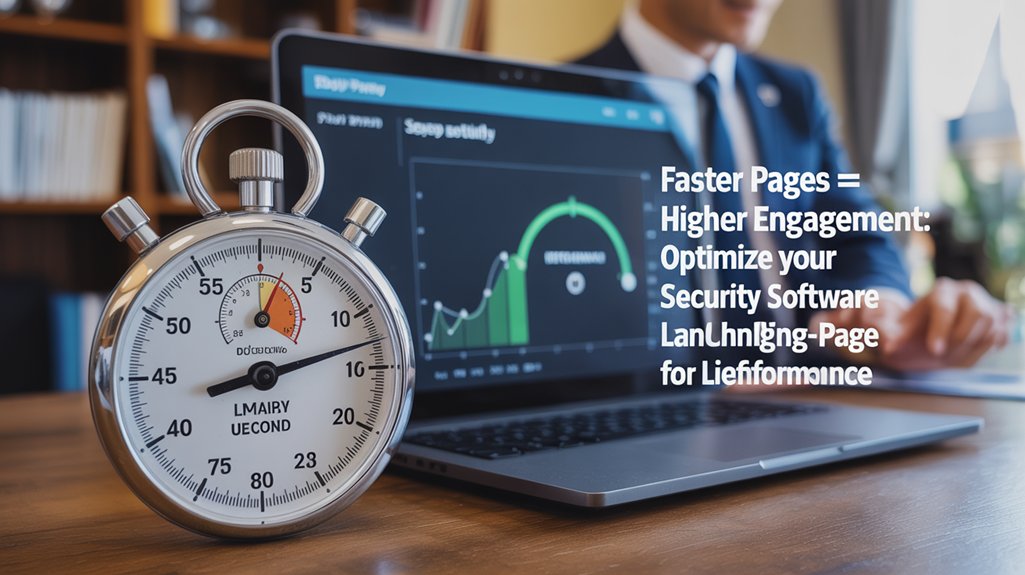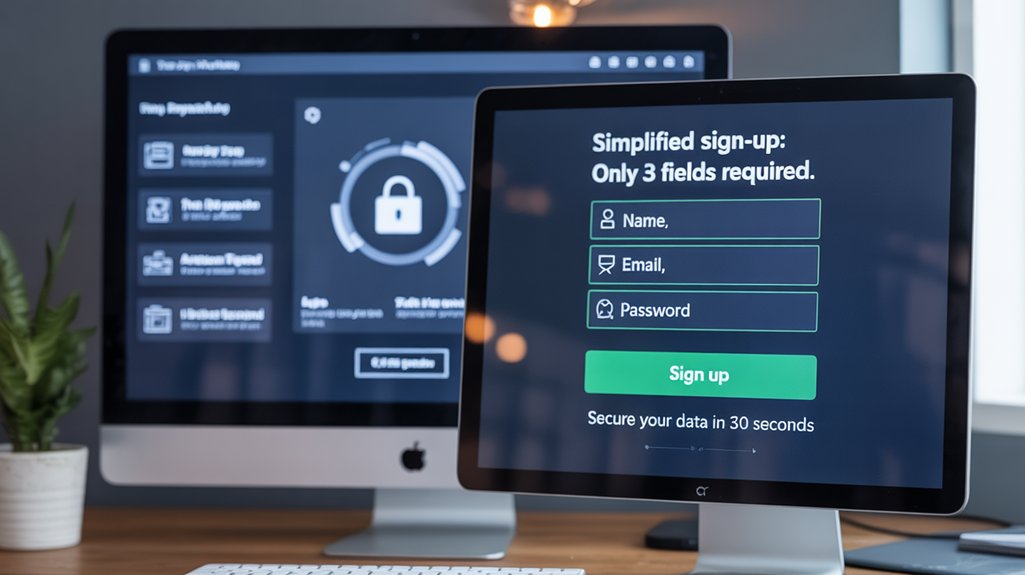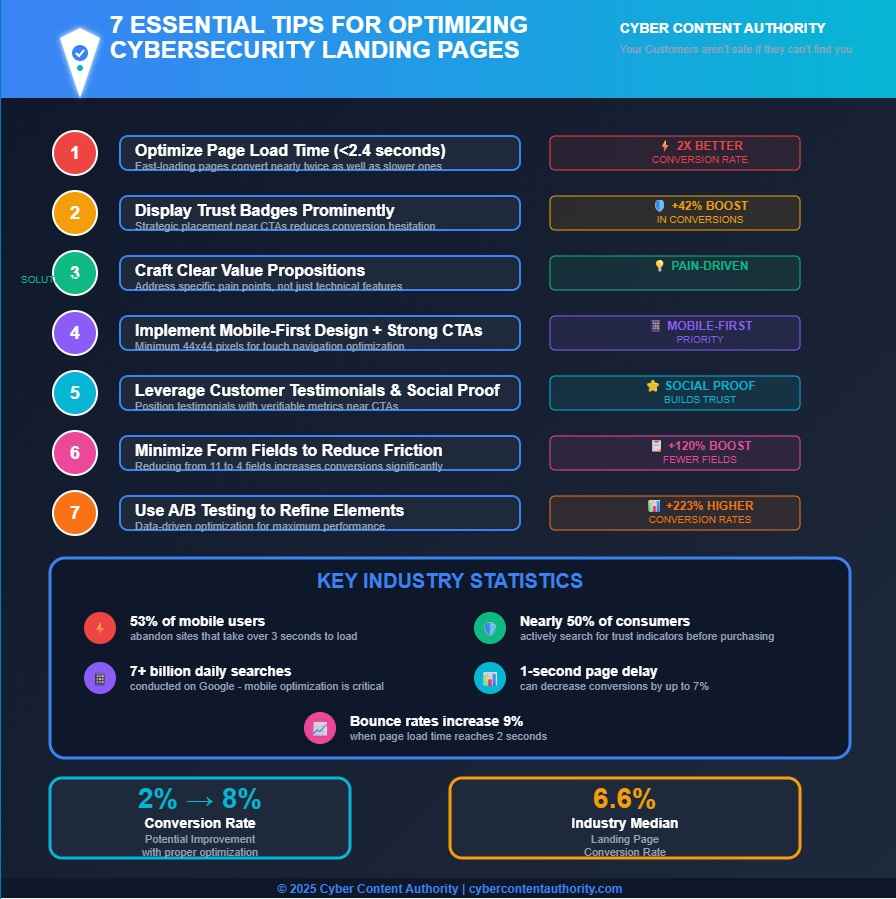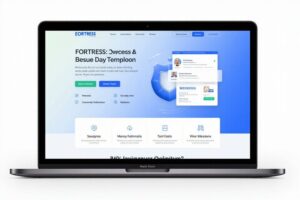In today’s competitive digital marketplace, security software companies face increasing pressure to convert site visitors into qualified leads. Optimizing security software landing pages, which serve as the critical threshold between customer acquisition and abandonment, requires strategic implementation of proven conversion elements rather than mere aesthetic adjustments. The difference between a 2% and 8% conversion rate often hinges on specific, measurable factors that security-focused organizations frequently overlook, despite their technical expertise. The following optimization techniques represent data-driven approaches that balance security credibility with conversion psychology.
Key Takeaways
- Optimize page load time to under 2.4 seconds, as faster-loading pages convert nearly twice as well as slower ones.
- Place trust badges strategically near conversion points to increase rates by up to 42% and address consumer security concerns.
- Craft value propositions that address specific security pain points and demonstrate clear ROI rather than focusing on technical features.
- Implement mobile-first design with prominent CTAs (minimum 44×44 pixels) and minimal form fields for better completion rates.
- Leverage social proof by positioning testimonials and case studies with verifiable metrics near calls-to-action for enhanced credibility.
Streamline Page Load Time for Higher Engagement

While security features remain the primary focus for software vendors, the technical performance of security software landing pages—specifically, their loading speed—serves as a critical, yet often overlooked determinant of conversion success.
Research demonstrates that pages loading within 2.4 seconds convert at nearly twice the rate of slower alternatives, whereas 53% of mobile visitors abandon sites exceeding the 3-second threshold. According to studies, bounce rates increase by 9% if a website takes 2 seconds to load, underlining the importance of speed.
To optimize load speed, implementers must prioritize content prioritization, design simplicity, and image optimization. A one-second delay in page load time can decrease conversions by as much as 7%, making speed optimization essential for maintaining visitor engagement.
In addition, through strategic mobile optimization, performance tools integration, and navigation ease enhancement, organizations can dramatically reduce exit rates, thereby increasing engagement metrics. Advanced monitoring solutions, such as Cloudflare, facilitate continuous evaluation against industry benchmarks.
Showcase Security Certifications and Trust Badges Prominently
Security software vendors must establish a strategic hierarchy of trust indicators, which begins with placement of SSL certificates and security verification badges above the fold.
This continues with payment security icons near transaction points, and concludes with industry-specific certifications in the footer. According to research, displaying trust badges can increase conversion rates by up to 42% higher when strategically implemented.
Throughout the landing page, trust badges should be positioned at critical decision points, such as adjacent to call-to-action buttons, within sign-up forms, and alongside pricing information, where they can effectively reduce conversion hesitation.
The visual prominence of these security indicators should follow a deliberate communication hierarchy, whereby the most recognizable certifications receive primary placement, followed by compliance badges that address specific customer concerns, and finally supplemented by third-party endorsements that reinforce the software’s credibility within the cybersecurity ecosystem.
Strategic Badge Placement
Nearly half of all consumers actively search for trust indicators before making purchasing decisions, underscoring the critical importance of strategic badge placement on security software landing pages.
Implementing a sophisticated badge visibility strategy, which positions trust indicators contextually throughout the user journey, allows organizations to capitalize on the psychological impact of familiarity while simultaneously addressing security concerns at critical conversion points.
For maximum efficacy, security certifications should be prominently displayed above the fold on security software landing pages, incorporated into checkout processes where transaction anxiety peaks, and consistently maintained across mobile interfaces, where, according to research, badge recognition can increase conversion rates by up to 42%.
The most recognized badges from McAfee and Verisign can substantially enhance customer trust levels when strategically placed throughout your website’s purchase journey.
Certification Communication Hierarchy
Establishing a clear certification communication hierarchy represents the next evolution in optimizing security software landing pages, particularly as organizations seek to convert visitor trust into measurable actions. The strategic arrangement of certification types, from industry standards to third-party validations, creates a visual trust framework that guides visitors toward conversion points. Studying landing page design can significantly enhance your ability to implement effective certification hierarchies.
| Certification Level | Impact Factor | Implementation Priority |
|---|---|---|
| Industry Standards | High | Primary Position |
| Encryption Badges | Medium-High | Secondary Prominence |
| Third-Party Badges | Medium | Supporting Role |
| Awards & Rankings | Supplementary | Contextual Placement |
Badge credibility increases when developers implement visual consistency, verifiable links to certification documentation, and regular updates that reflect current compliance status—practices which, when combined with strategic placement near conversion points, maximize the psychological security assurances needed for hesitant prospects.
Craft Clear Value Propositions That Address Customer Pain Points
Effective security software landing pages must feature value propositions that directly connect with customers’ pain points, particularly through highlighting solutions to specific security vulnerabilities, compliance challenges, and data protection concerns.
By framing messaging around immediate benefits rather than technical features, companies can demonstrate how their software resolves urgent security issues that keep decision-makers awake at night, such as ransomware protection, regulatory compliance, or breach prevention.
Security vendors who articulate clear, pain-driven value propositions that emphasize tangible outcomes, including reduced risk exposure, streamlined compliance processes, and enhanced threat detection capabilities, typically achieve higher conversion rates compared to competitors who focus solely on technical specifications.
In the increasingly oversaturated market, effective communication of ROI and risk mitigation benefits becomes the key differentiator that prevents potential customers from walking away in favor of competitors.
Pain-Driven Solutions
Why do exceptional security software landing pages convert at considerably higher rates? Importantly, they establish clear connections between customer pain points and solution alignment, demonstrating immediate value rather than merely showcasing features.
When developing landing page content, organizations must strategically address common security concerns, including data protection vulnerabilities, compliance challenges, and resource limitations, while simultaneously presenting tailored solutions that resolve these specific issues. Following Unbounce’s approach, security companies should emphasize solutions that allow customers to implement robust security measures without tech headaches.
Additionally, effective messaging incorporates industry-specific terminology that resonates with target audiences, emphasizes quantifiable ROI metrics, and leverages customer testimonials as social proof. Through meticulous alignment of security capabilities with existing operational challenges, companies establish credibility, cultivate trust, and position their offerings as essential rather than optional.
Immediate Benefit Messaging
While many security solutions overwhelm prospects with technical specifications, successful landing pages prioritize immediate benefit messaging that transforms complex capabilities into clear value propositions addressing specific customer pain points.
In highly competitive markets, creating benefit urgency through messaging that highlights immediate risks of inaction often yields higher conversion rates, particularly when coupled with solution-oriented language that demonstrates how the software resolves critical vulnerabilities. Sending security alerts and updates through SMS can significantly increase engagement as texts have a 98% open rate, substantially outperforming email communications.
In addition, articulating competitive advantages through simplified technical explanations, customer testimonials, and third-party endorsements establishes credibility while maintaining accessibility for decision-makers with varying technical expertise.
Through strategic A/B testing of value propositions, organizations can identify messaging frameworks that most effectively communicate both immediate and long-term security benefits.
Implement Mobile-First Design With Strong CTAS
As the digital landscape continues to prioritize mobile experiences across all sectors, security software companies must embrace mobile-first design principles that guarantee landing pages not only display correctly on smaller screens but also drive meaningful conversion through strategically placed calls-to-action.
When implementing mobile-first design for security software landing pages, developers should prioritize mobile usability through clean, uncluttered layouts that emphasize touch navigation, thereby enabling users to effortlessly interact with important security features. The use of single column layout ensures content is presented clearly and systematically for mobile users reviewing security software options. Additionally, with over 7 billion searches conducted on Google daily, it is crucial to ensure that the landing pages are optimized for mobile to capture the attention of potential customers.
In addition, CTAs must be prominently displayed with sufficient color contrast, appropriately sized for tapping (minimum 44×44 pixels), and strategically positioned near relevant content to maximize conversion potential during the vital decision-making moment.
Leverage Customer Testimonials and Social Proof
Convincing security software prospects requires more than impressive features and mobile optimization; it demands establishing unwavering trust through systematic implementation of credible customer testimonials and robust social proof elements.
When strategically displayed near calls-to-action, authentically crafted testimonials that highlight quantifiable results and specific problem-solving capabilities markedly enhance customer engagement and conversion rates.
- Placement Optimization – Position testimonial content above the fold and adjacent to conversion points, ensuring maximum visibility across both desktop and mobile interfaces.
- Testimonial authenticity – Incorporate video testimonials and case studies from recognizable industry figures, complete with verifiable metrics and implementation outcomes.
- Diversification Strategy – Deploy multiple social proof formats, including trust badges, certification icons, and user-generated reviews, to create extensive credibility architecture.
With proper implementation, these social proof elements can help your landing page exceed the 6.6% conversion rate benchmark that represents the industry median performance.
Minimize Form Fields to Reduce Conversion Friction

Slashing unnecessary form fields represents one of the most powerful, yet frequently overlooked enhancement strategies for security software landing pages, with research clearly demonstrating that reducing form fields from 11 to 4 can considerably increase conversions by up to 120%.
Form field enhancement, when implemented strategically, creates a frictionless user experience that greatly increases completion rates, particularly when aiming for the ideal three-field threshold that industry data confirms generates maximum conversion potential. This approach is validated by Kommunicate’s experience, which saw a 25.2% increase in clicks simply by removing a single form field.
Security software companies, which traditionally request extensive information due to compliance requirements, should conduct rigorous A/B testing to determine which fields are truly essential, thereby streamlining the conversion process while maintaining necessary data collection standards.
Use A/B Testing to Refine Landing Page Elements
While many security software companies implement landing pages without systematic optimization strategies, effective A/B testing represents the cornerstone methodology for empirically determining which page elements drive maximum conversion performance.
Research indicates that organizations conducting regular split tests achieve conversion rates 223% higher than their non-testing counterparts.
When implementing A/B testing strategies for security software landing page variations, consider:
- Isolate individual elements sequentially, particularly security badges, trust indicators, and technical specification displays, rather than testing multiple variables simultaneously, which frequently obscures causality and statistical significance.
- Guarantee adequate test duration to capture diverse user segments, accounting for B2B purchase cycle length within the cybersecurity sector.
- Analyze both conversion metrics and engagement indicators, such as time spent on technical documentation sections.
- Leverage expert consultation services to maximize results, as personalized expert advice can significantly enhance your landing page optimization strategy.
Optimize Your Security Software Landing Pages Today with These Tips!
Optimizing security software landing pages, through methodical implementation of evidence-based design principles and continuous refinement via data-driven testing, ultimately serves as a critical differentiator in today’s competitive cybersecurity marketplace. Organizations that meticulously apply these seven optimization strategies, particularly those focusing on establishing trust signals and reducing friction points throughout the conversion funnel, will inevitably achieve superior conversion rates while simultaneously enhancing their overall brand perception among security-conscious consumers.

Frequently Asked Questions
How Do Security Animations Impact User Trust and Conversion Rates?
Security animations enhance user trust through professional visualization while boosting conversion rates by increasing user engagement. Well-designed animation effects communicate complex security concepts efficiently, creating innovative interactions that resonate with modern consumers.
When Should I Use Video Demos Versus Static Screenshots?
Video demos excel for complex features and increasing engagement, ideal early in the sales funnel. Static screenshots provide clarity and rapid user comprehension when specific functionalities require focused attention.
How Frequently Should Landing Pages Be Updated for Security Credibility?
Security-focused landing pages warrant updates every 1-3 months to maintain credibility. Industry trends, vulnerability disclosures, and certification renewals should drive landing page frequency for ideal credibility updates and user trust.
What Color Schemes Perform Best for Security Software Conversions?
High-converting security software color schemes leverage color psychology with blues/greens for trust signals, contrasting oranges/reds for CTAs, and professional grays/whites for backgrounds—creating visual hierarchy that drives action.
How Does Pricing Presentation Affect Conversion Rates for Security Products?
Clear pricing presentation notably impacts conversion rates through pricing psychology that builds trust. Transparent value perception, with limited tiers and interactive elements, helps prospects quantify security investments against potential breaches.


